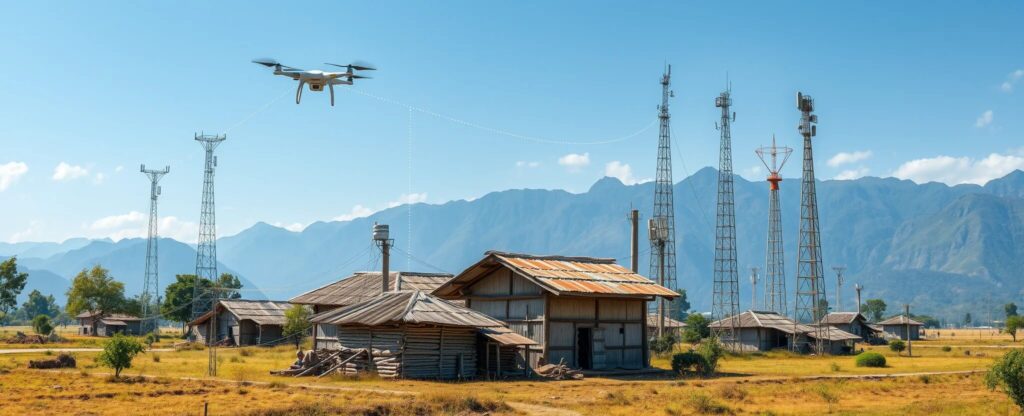
Overcoming Bandwidth Constraints: Edge ML in Remote and Rural Areas
As technology continues to develop at breakneck speed, it’s easy to forget that some parts of the world—particularly remote and rural areas—aren’t riding the same wave. With limited infrastructure and bandwidth constraints, these regions face challenges when it comes to accessing the vast potential of machine learning (ML).
Enter Edge ML—the game-changer for areas that need smart, localized solutions without relying on robust internet connections. This breakthrough isn’t just about convenience; it’s about empowering communities.
What Is Edge ML?
At its core, Edge ML is about bringing machine learning algorithms closer to where data is generated. Instead of relying on cloud servers or centralized data centers, which require stable and fast internet, ML processing happens directly on devices at the “edge” of the network—like smartphones, sensors, or local computers. This shift is especially beneficial for areas where bandwidth is limited or unreliable.
The idea is simple: process data locally to save bandwidth and minimize latency. In rural areas, this means data-heavy tasks like image recognition, predictive analytics, or even health diagnostics can happen without needing constant access to cloud-based resources.
The Bandwidth Bottleneck
One of the biggest barriers to deploying advanced technologies in rural and remote regions is bandwidth limitations. High-speed internet is often non-existent or spotty in these areas. Traditional cloud-based ML requires significant amounts of data to be uploaded and processed on remote servers. However, in low-bandwidth situations, sending large data sets to the cloud can be a slow and frustrating process, effectively stalling progress in areas like healthcare, agriculture, and education.
Edge ML bypasses this bottleneck by keeping data processing closer to home. Devices handle most of the work, only sending the necessary results or updates back to the cloud when connectivity allows. This drastically reduces the amount of data that needs to travel, cutting down on bandwidth requirements.
Improving Access to Healthcare
One of the most exciting applications of Edge ML in rural areas is healthcare. In regions where medical professionals are scarce, devices equipped with ML algorithms can assist in diagnosing illnesses, monitoring patient vitals, or predicting outbreaks. For example, portable devices using ML algorithms can scan medical images—like X-rays or MRIs—on the spot, providing immediate insights even where internet is lacking.
This not only saves time but also reduces the pressure on healthcare systems in remote areas. Doctors or health workers can make informed decisions faster without waiting for data to be processed externally. Edge-based health monitoring tools can also continuously track patients’ conditions and trigger alerts if something seems off, all without draining bandwidth.
Agriculture: Precision Farming Without Connectivity Woes

Rural areas are often farming hubs, and Edge ML offers an opportunity for more efficient, data-driven agriculture. Smart devices can gather real-time data from fields—such as soil quality, weather conditions, or pest activity—and process this information locally. The farmers receive immediate insights without needing to wait for an internet connection to upload data to a cloud server.
These smart farming techniques allow for more precise water usage, pest control, and crop management. With Edge ML, farmers can adjust practices on the fly based on real-time analysis, maximizing yield and minimizing resource waste, all while working within the limitations of rural connectivity.
Enhancing Education in Remote Areas
In areas where educational resources are limited, Edge ML can play a transformative role. Schools in rural regions often struggle with access to quality materials and teachers, but with ML-based tools that run on low-power, localized devices, students can benefit from personalized learning experiences tailored to their specific needs.
For instance, offline learning platforms powered by Edge ML can adapt lessons in real-time to suit a student’s progress, offering feedback and adjusting difficulty without needing an internet connection. This can be a game-changer for both teachers and students in remote areas, leveling the playing field when it comes to access to education.
Reducing Latency: Faster Decision-Making

Latency—how long it takes for data to be processed and a response to be generated—can be a major issue in cloud-based systems, especially in rural areas with unstable connections. Edge ML tackles this problem by processing data on-site, reducing delays and allowing for faster decision-making.
In critical industries like healthcare or transportation, the difference of a few seconds could mean life or death. With local processing, real-time data can be acted upon immediately, without waiting for a signal to travel to and from a remote server. This makes Edge ML crucial for safety-critical applications in regions with slow or unreliable internet.
Cost-Efficiency in Infrastructure Development
For many rural and remote areas, the cost of building out full-scale internet infrastructure is prohibitive. But instead of waiting for fiber-optic networks to reach every corner of the globe, Edge ML presents an affordable alternative. Because much of the computing power is handled locally, there’s less need to upgrade bandwidth-heavy infrastructure immediately.
Devices running Edge ML are generally more efficient, requiring fewer network resources. This can save both local governments and companies a lot of money, which is especially important in developing nations or remote locations with limited financial resources.
Smart Cities in Remote Areas?
Though we often think of smart cities as a big-city concept, there’s no reason rural areas can’t benefit from similar technologies. Edge ML allows for the deployment of smart sensors and automation systems that monitor everything from air quality to energy use, even in places with low connectivity.
Imagine a rural area with real-time traffic management systems that adapt to weather conditions or road congestion without needing constant communication with a central server. This would enhance both safety and efficiency while reducing the dependency on robust internet infrastructure.
Empowering Local Businesses and Entrepreneurs
In rural and remote areas, local businesses often face limitations when trying to scale or adopt modern technologies due to poor internet infrastructure. However, with Edge ML, small enterprises can leverage localized machine learning to improve their operations without depending on high-bandwidth connections.
For instance, a rural shop can use Edge ML-based point-of-sale (POS) systems that analyze purchasing trends, predict stock needs, and even manage customer loyalty programs—all without having to connect to a cloud server in real-time. This allows businesses to optimize inventory management, improve customer service, and make data-driven decisions that could boost profitability even in areas with connectivity challenges.
Renewable Energy Management in Off-Grid Areas

Many rural and remote areas rely on renewable energy sources like solar or wind power, especially when they’re off the traditional electrical grid. Edge ML can help in managing and optimizing these energy resources efficiently. For instance, solar farms in remote areas can use Edge ML algorithms to monitor energy production and predict maintenance needs based on localized conditions, without needing continuous cloud-based monitoring.
This localized decision-making ensures that these energy systems can operate autonomously, making adjustments in real-time based on energy demand, weather conditions, or potential faults in equipment. This kind of proactive management leads to increased reliability and longevity for renewable energy infrastructures in rural communities.
Disaster Management and Response
In remote and rural regions, natural disasters such as floods, wildfires, and earthquakes can be devastating, often leaving communities isolated due to poor communication networks. Edge ML can significantly aid disaster management efforts, providing real-time data processing and analysis right where it’s needed, even in disconnected areas.
For example, during a wildfire, drones equipped with Edge ML algorithms can be deployed to monitor fire spread in real-time, identifying hotspots and predicting the fire’s direction. This allows for faster, more accurate decision-making by local responders, helping them allocate resources and save lives. Similarly, in areas prone to flooding, local sensors running Edge ML models can analyze water levels and predict breaches, sending alerts even when there’s no internet.
Environmental Monitoring and Conservation
Edge ML can also be used for environmental conservation efforts in rural areas, especially where ecosystems are delicate, and continuous monitoring is required. By utilizing low-power sensors that collect data about local wildlife, water quality, or air pollution, Edge ML can process this information on-site, ensuring that ecosystems are monitored in real-time without relying on cloud connectivity.
For example, conservationists can track endangered species in remote areas, using cameras and sensors to detect movement, sound, or other biological markers. The data is processed on-site, providing immediate alerts if there’s a problem, such as illegal poaching activity or changes in habitat conditions. This ensures swift action can be taken to protect these environments without waiting for data to upload to a central server.
Security and Privacy in Edge ML
One major concern with traditional cloud-based machine learning is the potential risk to data privacy. In rural areas, where communities may be more vulnerable to data breaches or lack awareness about data security, Edge ML offers a more privacy-centric solution. By processing data locally, Edge ML reduces the need to send sensitive information over the internet, which can help protect individual and community privacy.
For instance, in healthcare applications, sensitive patient data doesn’t need to leave the local device, ensuring compliance with privacy laws and reducing the risk of breaches. Similarly, farmers using Edge ML to monitor their crops or livestock don’t have to worry about sharing potentially sensitive business information with third parties.
Bridging the Digital Divide
At its heart, the rise of Edge ML technology is a critical step toward bridging the digital divide between urban centers and rural or remote regions. Traditionally, rural communities have been left behind when it comes to accessing advanced technologies. With Edge ML, these communities can now participate in the digital economy, accessing cutting-edge tools that improve productivity, efficiency, and overall quality of life without needing the same level of infrastructure investment that urban areas enjoy.
From improving education and healthcare to enabling small businesses and protecting the environment, Edge ML is more than just a technological innovation; it’s a force for social and economic equality. This shift in computing power opens up new opportunities for remote and rural areas to thrive in a digital world.
Challenges to Overcome
Despite its many advantages, implementing Edge ML in remote areas isn’t without challenges. For one, device costs and power requirements may be prohibitive for some communities, even though Edge ML often reduces overall infrastructure costs. Additionally, ensuring that local devices are properly maintained can be difficult in regions where technical expertise is limited.
Another potential hurdle is the initial investment in technology. While Edge ML reduces the reliance on cloud infrastructure, there are still up-front costs in terms of hardware and software setup. Governments, NGOs, and tech companies will need to collaborate to make this technology accessible, ensuring that rural areas aren’t left out of the next wave of technological advancement.
The Future of Edge ML in Rural Areas

The potential of Edge ML in rural and remote areas is enormous, and we are just scratching the surface. As this technology evolves, we can expect more innovative solutions tailored specifically to the challenges of these regions. From agriculture to healthcare, Edge ML is laying the groundwork for a more connected and equitable future, where even the most isolated communities can access the benefits of machine learning.
By overcoming bandwidth constraints, Edge ML is paving the way for a new era of localized intelligence that transforms how people live and work in remote regions. It’s a testament to the power of innovation—solving problems with smart, decentralized solutions that don’t rely on the same infrastructure requirements as traditional cloud computing. The future is here, and with Edge ML, it’s reaching every corner of the globe.
Frequently Asked Questions (FAQ): Overcoming Bandwidth Constraints with Edge ML in Remote and Rural Areas
What is Edge ML?
Edge ML refers to machine learning that is processed locally on devices (such as sensors, smartphones, or edge servers) rather than in centralized cloud servers. This reduces the need for continuous internet connectivity and lowers latency by handling data processing closer to the source of data generation.
Why is Edge ML important for remote and rural areas?
In remote and rural areas, access to high-speed internet can be limited or unreliable. Edge ML allows local devices to perform data-heavy tasks, reducing the need for continuous internet bandwidth. This helps overcome connectivity issues while still enabling advanced data analysis, real-time decision-making, and machine learning-based solutions.
How does Edge ML help reduce bandwidth consumption?
Edge ML reduces bandwidth consumption by processing the majority of data locally on devices rather than sending all data to the cloud for analysis. Only essential updates or results are sent over the internet, minimizing the amount of data that travels between local devices and cloud servers.
What are the real-world applications of Edge ML in rural areas?
- Healthcare: Local diagnostic tools powered by Edge ML can assist in remote patient monitoring, illness detection, and health condition management without requiring real-time internet access.
- Agriculture: Farmers can use edge-powered devices to analyze soil conditions, track pest activity, and optimize resource use based on real-time data.
- Education: Offline learning platforms powered by Edge ML allow personalized education in areas with limited internet.
- Disaster Response: Drones and sensors using Edge ML can detect and respond to natural disasters in real-time, even in disconnected regions.
How does Edge ML improve healthcare in remote areas?
In healthcare, Edge ML allows portable devices to perform on-site diagnostics, such as analyzing medical images (X-rays, MRIs), monitoring vital signs, or predicting health emergencies in real-time. This is crucial in rural areas where access to medical professionals and high-speed internet may be limited.
Can Edge ML work without internet connectivity?
Yes, Edge ML can operate offline, as it processes data directly on local devices. However, for updates or communication with central servers (for data synchronization or updates), intermittent or occasional internet access may still be required.
How does Edge ML impact agriculture in rural areas?
Edge ML powers smart farming technologies by processing environmental data like soil moisture, weather conditions, or crop health on-site. This provides farmers with actionable insights in real time, allowing for precise adjustments in water use, pesticide application, and other key factors without relying on continuous internet connectivity.
Is Edge ML secure for data privacy in remote areas?
Yes, Edge ML enhances data privacy by processing sensitive information locally on devices. This minimizes the risk of data breaches since less data is transmitted over the internet. In applications like healthcare, where privacy is critical, Edge ML ensures patient data stays secure by keeping most of the analysis on-site.
What are the challenges of implementing Edge ML in remote areas?
Some challenges include:
- Initial device costs: Setting up edge devices can be costly for communities with limited financial resources.
- Power supply: Maintaining the energy needs of edge devices in off-grid locations can be tricky.
- Maintenance and technical expertise: Ensuring local devices are maintained and functioning may require trained personnel who might not be readily available in rural regions.
What are the advantages of Edge ML over traditional cloud-based ML?
- Reduced bandwidth use: Less data needs to be sent to the cloud.
- Lower latency: Real-time processing means faster responses, critical in applications like healthcare or disaster management.
- Greater data privacy: Sensitive information can be processed locally, reducing the risks of breaches.
- Cost savings: Reduces the need for extensive internet infrastructure development in rural areas.
How does Edge ML affect the digital divide?
Edge ML helps bridge the digital divide by providing rural and remote communities with access to advanced technologies without the need for high-speed internet. It democratizes access to machine learning tools, enabling more equal opportunities in sectors like education, healthcare, and agriculture.
Can Edge ML work in off-grid energy systems?
Yes! Edge ML can be integrated into renewable energy systems like solar or wind farms in off-grid areas. It helps optimize energy production and predict maintenance needs, ensuring these systems run efficiently without constant communication with cloud-based monitoring systems.
How will Edge ML evolve in the future for rural areas?
As Edge ML technology becomes more advanced and cost-effective, we can expect even greater adoption in rural areas. More affordable, low-power devices and increased collaboration between governments, NGOs, and tech companies will likely lead to further innovation, making edge-based solutions more accessible globally.
Resources for Further Reading on Edge ML in Remote and Rural Areas
- Edge AI: Harnessing Machine Learning on Edge Devices
This article provides a comprehensive overview of how edge computing works, its benefits, and its applications in various industries, including remote and rural areas. - Edge Computing for Rural Healthcare
An insightful look at how edge computing is transforming healthcare in underserved regions by enabling faster and more reliable diagnostic tools and medical monitoring. - Machine Learning for Smart Agriculture: The Role of Edge Computing
This resource discusses the impact of edge computing on precision farming, focusing on real-time data processing for better crop management in rural areas. - How Edge Computing is Bridging the Digital Divide
An article that explains the social impact of edge computing and how it can be a catalyst for economic growth in rural communities. - Privacy and Security in Edge Computing
A detailed guide on the security challenges and advantages of edge computing, particularly in areas with low infrastructure and limited data privacy protections. - Case Studies: Edge AI Solutions in Rural and Remote Areas
This paper compiles various case studies showing how edge AI is being used in real-world scenarios to improve healthcare, agriculture, and education in rural areas. - Renewable Energy Management with Edge ML
Focused on how edge technology is applied to monitor and optimize renewable energy systems, this article highlights its role in off-grid energy systems in remote areas. - Edge Computing in Disaster Response
Learn about how edge computing enhances disaster preparedness and management, especially in areas prone to natural calamities and with limited communication networks.